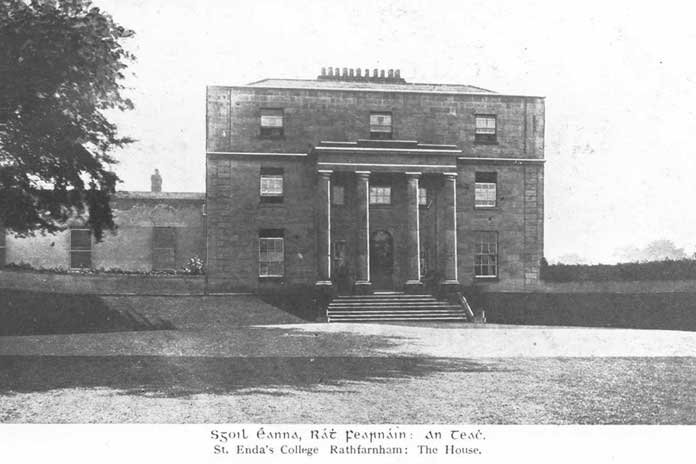

Rewind – St Enda’s Rathfarnham

By Sean Heffernan
For this week’s look back I am focusing on a building in Dublin 16 that has become synonymous with the 1916 Rising due to it’s previous owner, Padraig Pearse.
Situated off the Grange Road is St Enda’s Museum, which pays homage to one of the leaders of the insurrection 102 years ago, and the school he established in an effort to infuse a love of Irish traditions and language into those who studied there.

The land that the famous dwelling is built upon was owned by Thomas Connolly, who resided in the stately Castletown House in Celbridge.
In 1786, he leased it to Edward Hudson, who was the State dentist and also a physician, who had a house/business premises on Stephen’s Green.
The area was known as the “Fields of Odin”, which appears to be a nod to the Norse God who resided in ‘Valhalla’ and was worshipped by the Vikings.
It was this medic of note who built the house that still stands in Rathfarnham to this day.
The famous lawyer John Philpott Curran lived across the road and, against his neighbours wishes, he facilitated rendezvous’ between Curran’s daughter Sarah and Robert Emmet, a liaison that the eminent legal eagle had expressly forbidden.
Emmet was to find his life curtailed sooner than he likely thought, as his participation in a failed uprising against British rule in 1803 which led to his hanging outside St Catherine’s Church of Ireland on Thomas Street.
The owner’s son William was also a passionate advocate of Irish traditions and the language, and set-up a Celtic Society, and was a good friend of the head of the ‘Young Ireland’ movement, Thomas Davis.
In 1847 a lawyer Richard Moore is recorded at having bought the house, and he resided there until 1859 when a Major Richard Doyne, who fought in Crimea, became the next owner of the property.
In 1900, in what one might call a hugely ironic twist, the house and lands were leased to one Neville Chamberlain, a former officer in the British Army, who was based in India.
Chamberlain was the head of the Royal Irish Constabulary during the Rising in 1916.
In September 1908, Padraig Parse, with the help of Tipperary born school teacher Thomas McDonagh, setup a school on Oakley Road in Rathgar.
They named the school Scoil Eanna (St Enda’s), and they saw it as another part of the Gaelic Revival.
Two years later, with the help of a handful of wealthy donors, they signed a lease on Hermitage House in Rathfarnham, and its adjacent lands, and renamed the house St Enda’s.
The two exponents sought to mould their students along the lines of the famed Na Fianna Warriors of Celtic times.
Nature
As well as experiencing the nature around them, and sleeping outdoors on hikes, they also learned about famous Irish writers, kings and staged plays based on historical stories, such as Cú Chullian and The Táin and Pirate Queen Granuaile amongst others.
Eamonn Ceannt, and Con Colbert, two other key participants in the Rising, also taught pupils among this 50-acre setting.
Another connection that links the four men today is that they are among the 15 men in total associated with the insurrection who had train stations named after them – Pearse and Connolly Stations in Dublin, Colbert Station in Limerick and McDonagh Station in Kilkenny.
Pearse’s mother Margaret and his brother Willie lived in the school too, helping with the cooking and maintenance as well as other things.
She remained in the house after her sons executions in Kilmainham Goal and in 1919 with the help of also executed Thomas MacDonagh’s brother Joseph, reopened the school.
Fundraising in America enabled them to purchase the house and lands a year later.
The school closed its doors in 1935 however, Margaret and her daughter remained living there for a while after.
Pearse’s sister Margaret junior became a Fianna Fail TD from 1933 to 1937, and a year later she was appointed to the newly constituted Seanad Eireann, and remained a Senator until her death in 1968.
At this point the dwelling and the 50-acres were bequeathed to the State and the Office of Public Works set about renovating the house and creating a public park on the grounds.
The museum contains many of the artefacts that were present when the school was in operation, such as beds or desks the students undertook there studies on.
Today, the museum and its garden are a popular destination for families, with a café on site.
For more visit Pearse Museum.

